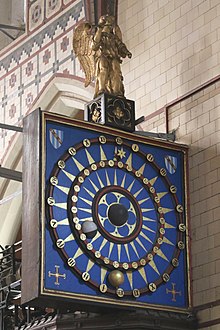

Ottery St Mary Astronomical Clock is a 14th-century astronomical clock in St Mary's Church, Ottery St Mary, in Devon in south-west England.


Ottery St Mary Astronomical Clock is a 14th-century astronomical clock in St Mary's Church, Ottery St Mary, in Devon in south-west England.
The south transept of the church of St Mary in Ottery St Mary houses the astronomical clock, [1] one of the oldest surviving mechanical clocks in England. It is commonly attributed to Bishop John de Grandisson, who was Bishop of Exeter (1327–69), and adheres to Ptolemaic cosmology with the Earth at the centre of the solar system. [2]
At the centre of the dial, the Earth is represented by a black ball. The Sun is represented by a gold ball which rotates round the outermost ring of the dial, showing the time. The Moon is represented by a ball which is half white and half black, which turns on its axis to show the phases of the moon. This ball rotates around the middle ring of the dial, numbered to show the days of the lunar month. The clock is similar in its display to the Exeter Cathedral astronomical clock in Devon and the Wimborne Minster astronomical clock in Dorset.[ citation needed ]
After 30 years of silence, the Ottery St Mary clock was restored to working condition in 1907 [3] by John James Hall FRAS of Exeter. The rededication service, on 20 May 1907, was attended by the Bishop of Exeter, Archibald Robertson, who formally set the clock going. [4]

Exeter Cathedral, properly known as the Cathedral Church of Saint Peter in Exeter, is an Anglican cathedral, and the seat of the Bishop of Exeter, in the city of Exeter, Devon, in South West England. The present building was complete by about 1400 and has several notable features, including an early set of misericords, an astronomical clock and the longest uninterrupted medieval stone vaulted ceiling in the world.
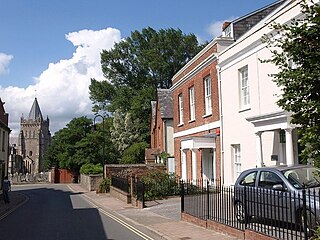
Ottery St Mary, known as "Ottery", is a town and civil parish in the East Devon district of Devon, England, on the River Otter, about 10 miles (16 km) east of Exeter on the B3174. At the 2001 census, the parish, which includes the villages of Metcombe, Fairmile, Alfington, Tipton St John, Wiggaton, and West Hill, had a population of 7,692. The population of the urban area alone at the 2011 census was 4,898.

The Prague astronomical clock or Prague Orloj is a medieval astronomical clock attached to the Old Town Hall in Prague, the capital of the Czech Republic.
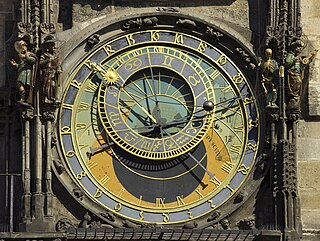
An astronomical clock, horologium, or orloj is a clock with special mechanisms and dials to display astronomical information, such as the relative positions of the Sun, Moon, zodiacal constellations, and sometimes major planets.

Cadhay is an historic estate in the parish of Ottery St Mary in Devon, England, 10 miles (16 km) east of Exeter and 5 miles (8 km) from the sea at Sidmouth. The mansion house known as Cadhay House, 1 mile (2 km) north-west of Ottery St Mary village, is a grade I listed Elizabethan building.

The Wells Cathedral clock is an astronomical clock in the north transept of Wells Cathedral, England. The clock is one of the group of famous 14th– to 16th–century astronomical clocks to be found in the West of England. The surviving mechanism, dated to between 1386 and 1392, was replaced in the 19th century, and was eventually moved to the Science Museum in London, where it continues to operate. The dial represents the geocentric view of the universe, with the Sun and Moon revolving round a central fixed Earth. It may be unique in showing a philosophical model of the pre-Copernican universe.

The King's School is a secondary school and sixth form located in Ottery St Mary, Devon, England. It was established as a choir school by the bishop John Grandisson in 1335, but was replaced by a grammar school by Henry VIII in 1545. It became a comprehensive school in 1982, and an academy in 2011. The school's pupils are mainly drawn from its five feeder primaries in the surrounding area: Ottery St Mary primary school, West Hill Primary School, Payhembury Church of England Primary School, Feniton Church of England Primary School and Tipton St John Church of England Primary School.

John de Grandisson, also spelt Grandison, was Bishop of Exeter, in Devon, England, from 1327 to his death in 1369. Several works of art associated with him survive in the British Library, the British Museum and the Louvre in Paris.
John Northwood was an English medieval churchman and university chancellor.

The Exeter Cathedral Astronomical Clock is a fifteenth-century astronomical clock in Exeter Cathedral, England. It displays the hour of the day, the day of the lunar month and the phase of the moon. The modern clock mechanism was installed in 1885 by Gillett & Bland of Croydon, and restored in 1910.

Wimborne Minster astronomical clock is a fourteenth-century astronomical clock in Wimborne Minster in Dorset, regarded as "one of the most ancient working clocks in Europe."
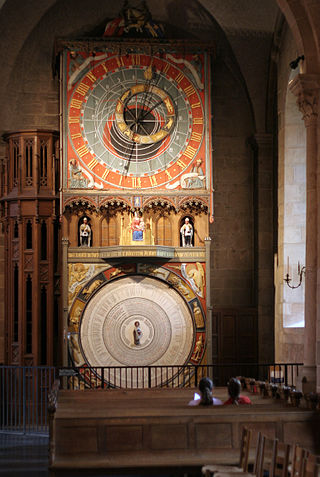
Lund astronomical clock, occasionally and at least since the 16th century referred to as Horologium mirabile Lundense, is a 15th-century astronomical clock in Lund Cathedral. Mentioned in written sources for the first time in 1442, it was probably made and installed sometime around 1423–1425, possibly by Nikolaus Lilienfeld. It is part of a group of related medieval astronomical clocks found in the area around the south Baltic Sea. In 1837 the clock was dismantled. Between 1909 and 1923, it was restored by the Danish clockmaker Julius Bertram-Larsen and the Swedish architect responsible for the upkeep of the cathedral, Theodor Wåhlin. From the old clock, the face of the clock as well as the mechanism, which was largely replaced during the 18th century, was salvaged and re-used. The casing, most parts of the calendar which occupies the lower part, and the middle section were made anew.

The Ploërmel Astronomical Clock is a 19th-century astronomical clock in Ploërmel in Brittany, in north-west France.

St Mary's Church is a Grade I listed building, a parish church in the Church of England in Ottery St Mary, Devon.

Mohuns Ottery or Mohun's Ottery, is a house and historic manor in the parish of Luppitt, 1 mile south-east of the village of Luppitt and 4 miles north-east of Honiton in east Devon, England. From the 14th to the 16th centuries it was a seat of the Carew family. Several manorial court rolls survive at the Somerset Heritage Centre, Taunton, Somerset.

John James Hall was an eminent horologist and author who restored many early clocks.

Knightstone is an historic manor in the parish of Ottery St Mary in Devon. The surviving mediaeval and Tudor grade I listed manor house is situated one mile south-east of St Mary's Church, Ottery St Mary. It was the seat of the Bittlesgate family, the heiress of which Joan Bittlesgate, daughter of Thomas Bittlesgate by his wife Joan Beauchamp, was the wife of Richard Woodville, grandfather of Elizabeth Woodville (c.1437-1492) Queen consort of England as the spouse of King Edward IV. In 1381 the Bittlesgate family obtained a licence from the Bishop of Exeter to build and operate a private chapel at their home, but no trace of the structure survives. The house has been much altered since the time of the Bittlesgate family. One Tudor-era fireplace survives in a bedroom.
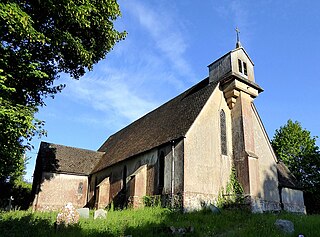
St James' and St Anne's Church is a Church of England church in Alfington, Devon, England. It was built in 1849 at the expense of Sir John Taylor Coleridge and designed by William Butterfield.
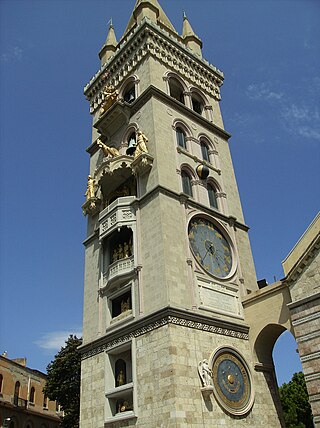
The astronomical clock of Messina is an astronomical clock constructed by the Ungerer Company of Strasbourg in 1933. It is built into the campanile of Messina Cathedral.

The Zytturm is a 13th-century tower in Zug, Switzerland, which houses an astronomical clock. The tower, which is 52 metres high, is located on Kolinplatz in the old town centre.